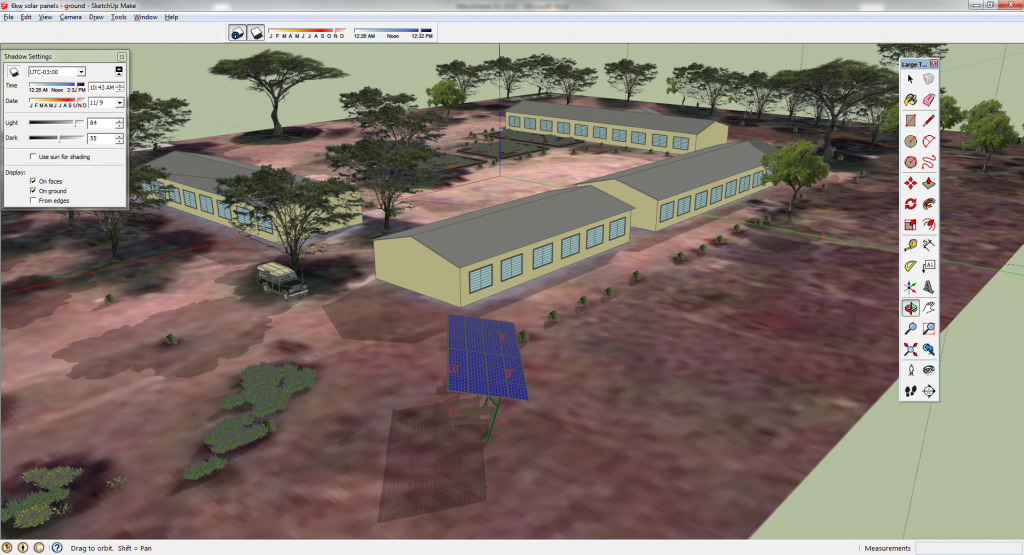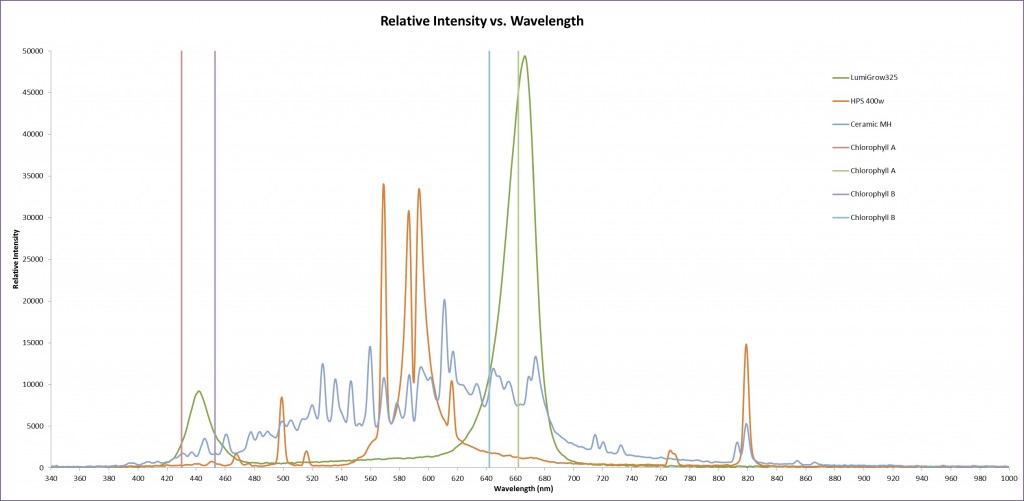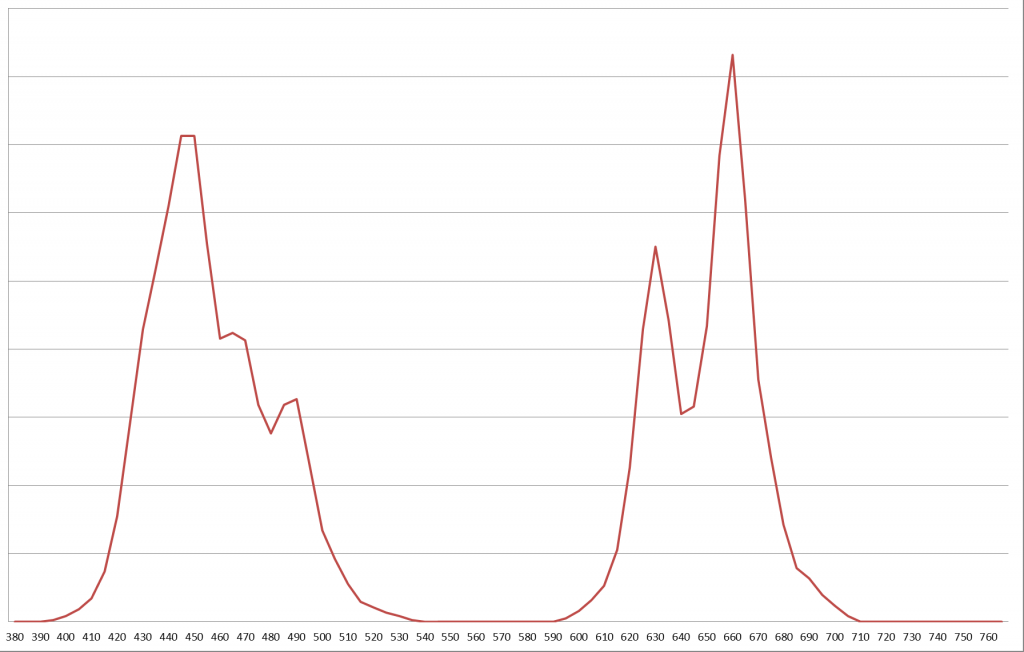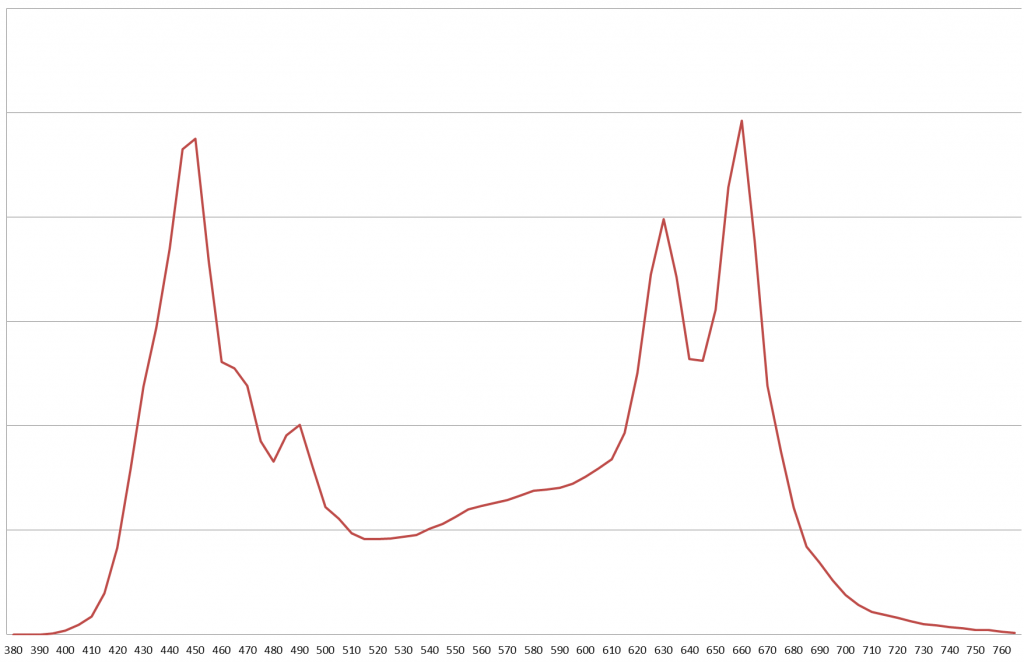WhatDoYouDo
New Member
Hi All,
I have been reading 100’s of topics, scholarly articles, and comparing some existing growing lights but everyone seems to recommend different things. This leaves me with some questions, so I hope someone with more experienced can roll one up and help me hammer out the details so I and others fully understand what’s going on.
For reference, here is a complete spectrum I have put together over time.
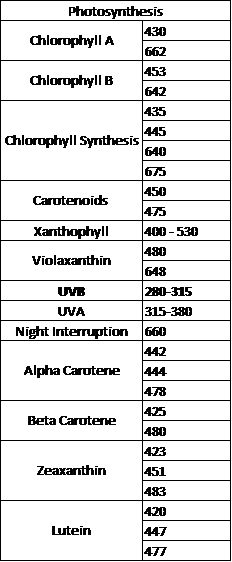
The biggest downfall I see for these plants is an incomplete spectrum. I put together a list of key wavelengths used by popular companies, but noticed that most companies use a formula similar to this:
6% Blue Leds 450mn
14% Blue Leds 470mn
30% Red Leds 640
50% Far Red leds 660mn
Some lights mix in white to provide a more complete spectrum, some suggest that white/green will prohibit growth, anyone have experience with using white COB led vs. just blue/red? I know some LED grow lights only use white and they work just fine. I noticed Cree has COBs in the CXA series that hit key wavelengths, so should a few be used to provide a more complete spectrum?
I would like to make a light that hits all the key wavelengths to promote max growth. I am also open to using a computer to control different spectrum's in different amounts/times, but i need to know what to include before hand.
Some companies use 612nm, but that does not seem to hit any key wavelengths. Am I missing something? Same for 730. i understand it is known as the Emerson effect. You add 10% Far red (730-740nm) and you will have an increase in light response from certain photo-receptors in plants that causes plant mass to increase and grow at better rates. when should this be used, and is this most plants or cannabis?
Why does no one use the 430nm, as it supports Chlorophyll A? I see 470nm supports Carotenoids, carotene, and lutein, but 450 and 470 hardly do much for Chlorophyll A. Is 430nm not needed because of the 660nm being a better wavelength nm that does the same thing?
I examined the spectrum power distributions of 6 popular grow lights, some suggested they had lights 12 spectrums, but the spectrum power distribution showed they don’t (intensity was less than 0.01%, it doesn’t even show an sort of spike on the charts of intensity vs wavelength). For example, there is no real spike at 430 for some of these companies, some of which insist they have an LED at that wavelength but keep the actual recipe a secret.
Here is the graph I am talking about. I removed the names of the companies because I am not here to talk about brand or quality and this is information that is easily available off the internet in great detail. Note, that orange us a 400w HPS and the light blue is Ceramic MH.
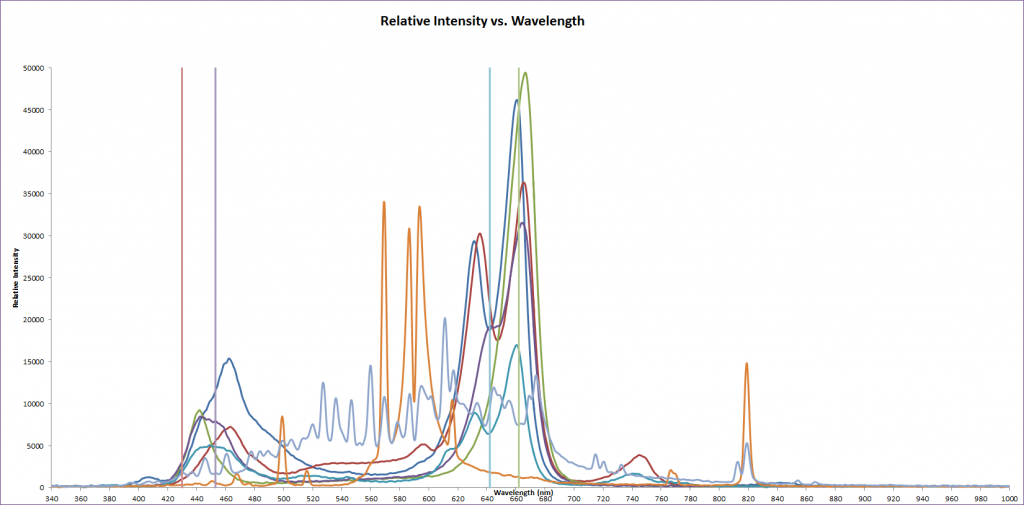
I also noticed some companies are ‘always on’ and some companies control the intensity of blue/red independently. Are different spectra really necessary for veg and flowering stages?
If I understand correctly, the plants go from seedling, to veg cycle, to flower cycle?
Veg LED cycles contain mostly blue leds, some with a strict focus on 450 – 470, are their no other wavelengths that are important during this time? What about 430 to support Chlorophyll A?
During the veg stage a plant will be photosynthesising as much as possible to grow as large as possible. Are you limiting it to only blue to prevent large growth, right? Or is there a different reason? Why not just blast them with the full spectrum for 24/7?
After the Veg stage, does it go directly into the Flowring stage?
At this point, it should be using the full spectrum but heavy amounts of red, right? Like the ratio above, 8:2. Should white also be involved in this mix?
I understand there is an important dark cycle for this period if you want big buds. 12/12 should trick the plant into thinking it is fall and trigger hormones to produce flowers, ect. I saw one person suggested that a cycle of 24 hours on, 12 hours off can produce even better results, does anyone know if that is true and is a good goal to use?
When is a good time to introduce the UVB, and is too much UVB a bad thing and should it be introduced later in the flowering cycle? Should it follow the 12/12 rule or only a few hours?
If I have this correct, the best grow light would have an option of just blue for the Veg stage. This stage should have more light, atleast 18/6 or 24/0. Once the plant seems to be a good size, you change the light schedule to 12/12 to trick it into flowering. Turn on all the lights, and push for max growth. Once you have buds, you use a UVB light to increase the THC. Is that all? No other tricks or anything that I should know about?
If someone just wanted the largest plants possible, for example a grow house, would they ignore the blue only veg state to promote a huge plant?
Are their spectrums that should be avoided? Are their spectrums that need to be added that are generally forgotten?
I am thinking that the general ratio that is used is just old information that has been passed down and copied from other people. I would like to make a more custom and beneficial range of wavelengths that support better growth and final product.
Lastly, does anyone know a lot about laser treatment of seeds? I found a few articles that suggest a 5mw – 10mw laser in the 640 – 660nm area will make seeds germinate twice as fast and produce larger plants.
My goal is to make a great light that can grow cannabis very well, but also supports the growth of various types of plants, especially produce. Later, I plan to get my masters in plant science and perfect this light. Unfortunately, my current engineering degree lacks all the needed info about growing plants and LEDs. It would be great to enter a master’s program with a good understanding of plant growth, have a quality light I can work with and improve upon, then leave the program with a degree while making key advancements in the field of LED lighting. Basically, I want to help myself but also bring an amazing product to the growing community that leads the field. I am not interested in growing cannabis personally; I am interested in the growing light for use of indoor food crops. With the amazing growth of the cannabis industry, and the expect growth to come in the next 5 years, it would be foolish to not design a product for that market that also can be used for other things.
My interest is growing produce on larger scales not currently seen. If people are interested in what i am doing, you can always ask. =]
I also a co-founder of an international 501c3 nonprofit. Our goal is to install solar panels and LED lighting at schools in developing countries. We would like to use these growing lights later in combination with solar panels and other renewable energy to produce high quality food crops and medical crops in parts of the world were food does not grow easily. Especially where crops fail due to heat, bugs, cold climate, ect. I think that would be the definition of me living out my dream.
Anyway, I hope I did not bore you and someone can help me get going in the right direction!
I have been reading 100’s of topics, scholarly articles, and comparing some existing growing lights but everyone seems to recommend different things. This leaves me with some questions, so I hope someone with more experienced can roll one up and help me hammer out the details so I and others fully understand what’s going on.
For reference, here is a complete spectrum I have put together over time.

The biggest downfall I see for these plants is an incomplete spectrum. I put together a list of key wavelengths used by popular companies, but noticed that most companies use a formula similar to this:
6% Blue Leds 450mn
14% Blue Leds 470mn
30% Red Leds 640
50% Far Red leds 660mn
Some lights mix in white to provide a more complete spectrum, some suggest that white/green will prohibit growth, anyone have experience with using white COB led vs. just blue/red? I know some LED grow lights only use white and they work just fine. I noticed Cree has COBs in the CXA series that hit key wavelengths, so should a few be used to provide a more complete spectrum?
I would like to make a light that hits all the key wavelengths to promote max growth. I am also open to using a computer to control different spectrum's in different amounts/times, but i need to know what to include before hand.
Some companies use 612nm, but that does not seem to hit any key wavelengths. Am I missing something? Same for 730. i understand it is known as the Emerson effect. You add 10% Far red (730-740nm) and you will have an increase in light response from certain photo-receptors in plants that causes plant mass to increase and grow at better rates. when should this be used, and is this most plants or cannabis?
Why does no one use the 430nm, as it supports Chlorophyll A? I see 470nm supports Carotenoids, carotene, and lutein, but 450 and 470 hardly do much for Chlorophyll A. Is 430nm not needed because of the 660nm being a better wavelength nm that does the same thing?
I examined the spectrum power distributions of 6 popular grow lights, some suggested they had lights 12 spectrums, but the spectrum power distribution showed they don’t (intensity was less than 0.01%, it doesn’t even show an sort of spike on the charts of intensity vs wavelength). For example, there is no real spike at 430 for some of these companies, some of which insist they have an LED at that wavelength but keep the actual recipe a secret.
Here is the graph I am talking about. I removed the names of the companies because I am not here to talk about brand or quality and this is information that is easily available off the internet in great detail. Note, that orange us a 400w HPS and the light blue is Ceramic MH.

I also noticed some companies are ‘always on’ and some companies control the intensity of blue/red independently. Are different spectra really necessary for veg and flowering stages?
If I understand correctly, the plants go from seedling, to veg cycle, to flower cycle?
Veg LED cycles contain mostly blue leds, some with a strict focus on 450 – 470, are their no other wavelengths that are important during this time? What about 430 to support Chlorophyll A?
During the veg stage a plant will be photosynthesising as much as possible to grow as large as possible. Are you limiting it to only blue to prevent large growth, right? Or is there a different reason? Why not just blast them with the full spectrum for 24/7?
After the Veg stage, does it go directly into the Flowring stage?
At this point, it should be using the full spectrum but heavy amounts of red, right? Like the ratio above, 8:2. Should white also be involved in this mix?
I understand there is an important dark cycle for this period if you want big buds. 12/12 should trick the plant into thinking it is fall and trigger hormones to produce flowers, ect. I saw one person suggested that a cycle of 24 hours on, 12 hours off can produce even better results, does anyone know if that is true and is a good goal to use?
When is a good time to introduce the UVB, and is too much UVB a bad thing and should it be introduced later in the flowering cycle? Should it follow the 12/12 rule or only a few hours?
If I have this correct, the best grow light would have an option of just blue for the Veg stage. This stage should have more light, atleast 18/6 or 24/0. Once the plant seems to be a good size, you change the light schedule to 12/12 to trick it into flowering. Turn on all the lights, and push for max growth. Once you have buds, you use a UVB light to increase the THC. Is that all? No other tricks or anything that I should know about?
If someone just wanted the largest plants possible, for example a grow house, would they ignore the blue only veg state to promote a huge plant?
Are their spectrums that should be avoided? Are their spectrums that need to be added that are generally forgotten?
I am thinking that the general ratio that is used is just old information that has been passed down and copied from other people. I would like to make a more custom and beneficial range of wavelengths that support better growth and final product.
Lastly, does anyone know a lot about laser treatment of seeds? I found a few articles that suggest a 5mw – 10mw laser in the 640 – 660nm area will make seeds germinate twice as fast and produce larger plants.
My goal is to make a great light that can grow cannabis very well, but also supports the growth of various types of plants, especially produce. Later, I plan to get my masters in plant science and perfect this light. Unfortunately, my current engineering degree lacks all the needed info about growing plants and LEDs. It would be great to enter a master’s program with a good understanding of plant growth, have a quality light I can work with and improve upon, then leave the program with a degree while making key advancements in the field of LED lighting. Basically, I want to help myself but also bring an amazing product to the growing community that leads the field. I am not interested in growing cannabis personally; I am interested in the growing light for use of indoor food crops. With the amazing growth of the cannabis industry, and the expect growth to come in the next 5 years, it would be foolish to not design a product for that market that also can be used for other things.
My interest is growing produce on larger scales not currently seen. If people are interested in what i am doing, you can always ask. =]
I also a co-founder of an international 501c3 nonprofit. Our goal is to install solar panels and LED lighting at schools in developing countries. We would like to use these growing lights later in combination with solar panels and other renewable energy to produce high quality food crops and medical crops in parts of the world were food does not grow easily. Especially where crops fail due to heat, bugs, cold climate, ect. I think that would be the definition of me living out my dream.
Anyway, I hope I did not bore you and someone can help me get going in the right direction!






